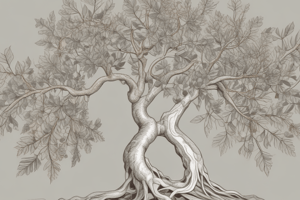Podcast
Questions and Answers
What is the primary function of roots in plants?
What is the primary function of roots in plants?
- Increase the height of the plant
- Conduct sugars from leaves to roots
- Provide structural support to leaves and flowers
- Store carbohydrates and other substances (correct)
Which root type is characterized by a deep, single main root?
Which root type is characterized by a deep, single main root?
- Taproots (correct)
- Fibrous Roots
- Lateral Roots
- Adventitious Roots
What is the role of root hairs in plants?
What is the role of root hairs in plants?
- To enhance stability against soil erosion
- To transport sugars to the stem
- To increase surface area for absorption (correct)
- To store water during drought
What is a primary function of stems in plants?
What is a primary function of stems in plants?
Which type of stem is typically soft and green?
Which type of stem is typically soft and green?
Flashcards are hidden until you start studying
Study Notes
Roots
-
Anchorage:
- Secure plants to the soil.
-
Absorption:
- Take up water and nutrients from the soil.
-
Storage:
- Store carbohydrates and other substances (e.g., starch, sugars).
-
Transport:
- Conduct water and dissolved minerals to the stem through xylem.
-
Root Types:
- Taproots: Deep, single main roots (e.g., carrots).
- Fibrous Roots: Network of thin roots (e.g., grasses).
-
Root Anatomy:
- Root Hairs: Increase surface area for absorption.
- Meristematic Zone: Growth region where new cells form.
Stems
-
Support:
- Hold up leaves and flowers, maintaining plant structure.
-
Transport:
- Conduct water and nutrients from roots to leaves (xylem) and transport sugars from leaves to other parts (phloem).
-
Growth:
- Allow for vertical and lateral growth through apical and lateral meristems.
-
Storage:
- Store food and water (e.g., swollen stems like potatoes).
-
Stem Types:
- Herbaceous Stems: Soft, green, not woody (e.g., basil).
- Woody Stems: Hard, durable, support larger plants (e.g., trees).
-
Node and Internode:
- Node: Points where leaves and buds emerge.
- Internode: Stem segment between two nodes.
-
Bud Types:
- Terminal Buds: At the top of the stem, responsible for upward growth.
- Axillary Buds: Located at the leaf axils, can develop into branches or flowers.
Roots
- Roots anchor plants in the soil, ensuring stability.
- Roots are responsible for absorbing water and essential nutrients from the soil.
- Roots also function as storage organs, holding carbohydrates like starch and sugars.
- Water and dissolved minerals are transported from roots to the stem through the xylem.
- Taproots are deep, single main roots found in plants like carrots.
- Fibrous roots are networks of thin roots characteristic of grasses.
- Root hairs significantly increase the surface area for absorption.
- The meristematic zone is the growth region where new root cells are formed.
Stems
- Stems provide structural support, holding up leaves and flowers, maintaining the plant's upright form.
- Stems facilitate transport, carrying water and nutrients from roots to leaves via the xylem and sugars from leaves to other parts using the phloem.
- Stem growth occurs through apical and lateral meristems, allowing for vertical and lateral extension.
- Stems can store food and water, as seen in swollen stems like potatoes.
- Herbaceous stems are soft, green, and non-woody, typical of plants like basil.
- Woody stems are hard, durable, and provide support for larger plants like trees.
- Nodes are points on the stem where leaves and buds emerge.
- Internodes are the segments of the stem between two nodes.
- Terminal buds are located at the stem's tip and are responsible for upward growth.
- Axillary buds are positioned in the leaf axils, having the potential to develop into branches or flowers.
Studying That Suits You
Use AI to generate personalized quizzes and flashcards to suit your learning preferences.




